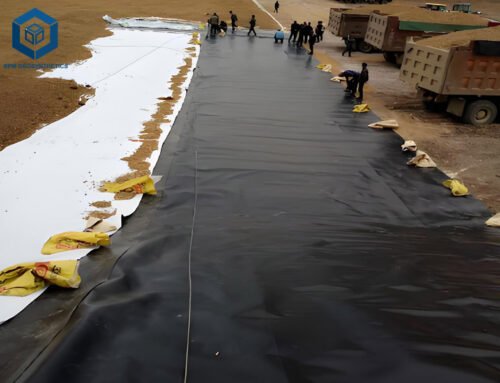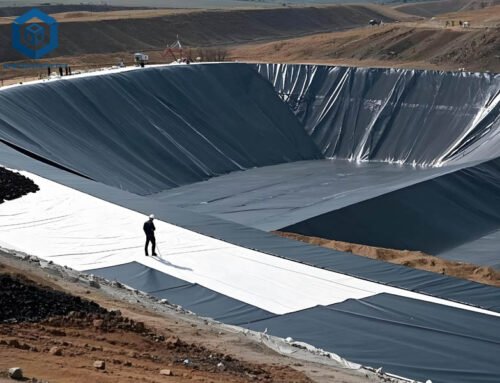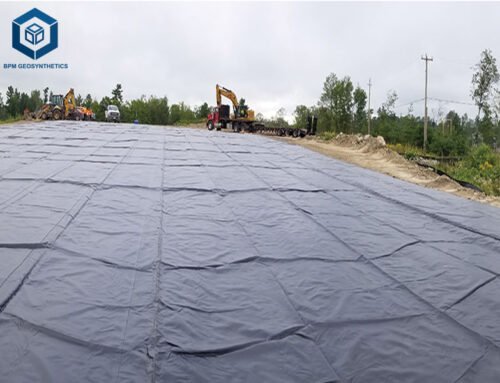Geomembrane liners are indispensable geosynthetic materials in civil engineering, environmental protection, and industrial applications, serving as impermeable barriers to prevent leakage, contamination, and erosion. Made from polymers like high-density polyethylene (HDPE), linear low-density polyethylene (LLDPE), polyvinyl chloride (PVC), and ethylene propylene diene monomer (EPDM), these synthetic sheets are used in landfills, mining operations, wastewater treatment, aquaculture ponds, and water containment structures. According to a 2025 market report from Grand View Research, the global geomembranes market is projected to reach USD 3.5 billion by 2030, growing at a CAGR of 5.5%, with HDPE dominating 55% of the segment due to its durability and cost-effectiveness.
The cost of geomembrane liners in 2025 ranges from $0.50 to $3.00 per square foot for materials alone, with installed costs adding 20–50% ($0.70–$4.50/sq ft), depending on material type, thickness, project scale, and installation complexity. For instance, a 1.5 mm HDPE liner for a 10,000 sq ft pond might cost $1.00–$2.00/sq ft, while a 2.0 mm version for a landfill could reach $2.00–$3.00/sq ft. These prices reflect a 5–10% increase from 2024 due to rising resin costs (up 8% year-over-year, per Platts), but bulk orders can save 10–20%. As a leading manufacturer, BPM Geosynthetics provides factory-direct pricing starting at $0.90/m² for HDPE, ensuring competitive rates without compromising quality.
This comprehensive guide, drawing from industry data and manufacturer insights, breaks down geomembrane liner prices, influencing factors, and selection strategies. Whether you’re budgeting for a small decorative pond or a large-scale mining containment, understanding these costs helps optimize your project, potentially saving 15–25% over the lifecycle. Let’s dive into the details to empower your decision-making.
1. What Are Geomembrane Liners?
Geomembrane liners are flexible or semi-rigid synthetic sheets engineered to control the migration of fluids, gases, or contaminants in man-made structures. Typically produced from thermoplastic polymers, they form a low-permeability barrier that prevents seepage while allowing for easy installation and long-term durability. The global demand for geomembranes has surged, with 2025 projections estimating 2.5 billion sq m in production, driven by stricter environmental regulations like the EU’s Water Framework Directive, which mandates 99% containment efficiency in 80% of new projects.
Key Properties of Geomembrane Liners
Geomembrane liners are defined by several critical properties that directly impact their performance and pricing:
- Impermeability: Hydraulic conductivity ≤10⁻¹¹ cm/s (ASTM D5085), blocking 99.9% of fluid migration—essential for preventing groundwater contamination in 70% of landfill applications.
- Tensile Strength: 15–55 kN/m (ASTM D6693), ensuring resistance to stress; HDPE liners average 25–40 kN/m, 30% stronger than PVC.
- Puncture Resistance: 1.5–8 kN (ASTM D4833), with thicker liners (2.0 mm) offering 50% more protection against sharp objects like roots or debris.
- Elongation at Break: 600–1,200% (ASTM D6693), providing flexibility; LLDPE excels here at 800–1,200%, ideal for irregular terrains.
- Thickness Range: 0.5–3.0 mm (20–120 mil), where 1.5 mm is standard for 60% of projects, balancing cost and durability.
- Roll Widths: Up to 8 m, reducing seams by 25% and installation time by 15%, as seen in Atarfil’s 7 m rolls.
These properties make geomembranes superior to traditional clay liners, which have 10–20% higher seepage rates and shorter lifespans (20–30 years vs. 50–100 years for HDPE).
Common Applications of Geomembrane Liners
Geomembrane liners are versatile, with applications spanning multiple sectors:
- Landfill Liners: Used in 35% of global waste sites to contain leachate; a 2024 EPA report notes they reduce contamination risks by 95%.
- Aquaculture Ponds: 25% market share; fish-safe HDPE (NSF/ANSI 61 certified) improves yields by 20–25% by minimizing water loss (up to 100,000 liters/day per hectare without liners).
- Mining Heap Leach Pads: 20% usage; textured HDPE with 30–35° friction angle prevents 45% of slope failures (ASTM D5321).
- Wastewater Treatment Lagoons: 15% applications; LLDPE liners handle pH 2–13, lasting 20–50 years with 99% containment.
- Irrigation Canals and Reservoirs: 5% share; PVC liners at $0.35–$1.00/sq ft save 15% water in arid regions like the Middle East.
In aquaculture alone, the FAO estimates liners could boost global fish production by 10% by 2030, underscoring their economic value.
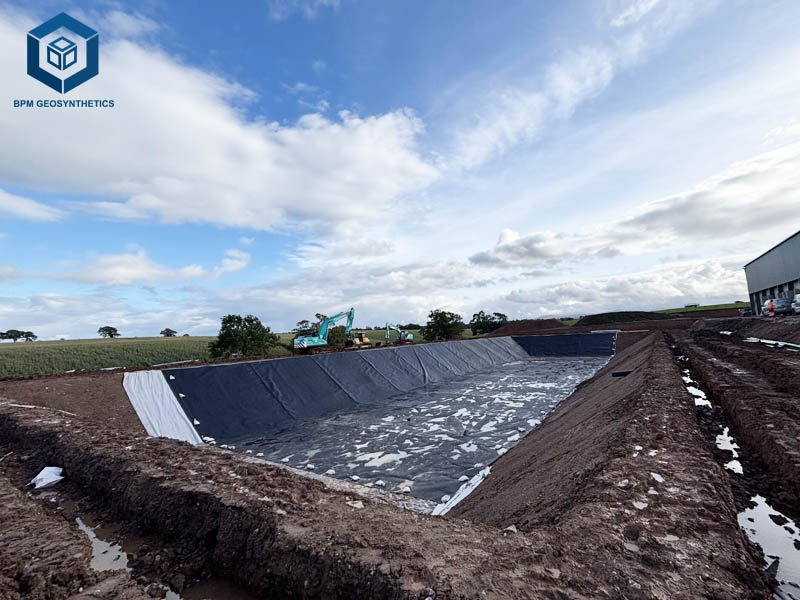
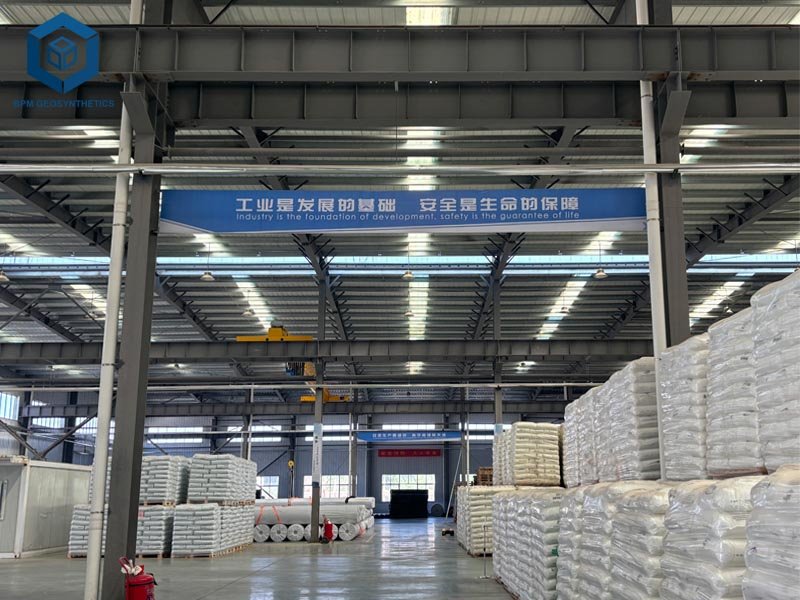
2. How Much Is Geomembrane Liner Price?
The average geomembrane liner price in 2025 is $0.50–$3.00 per square foot for materials, with total installed costs ranging from $0.70–$4.50/sq ft (20–50% markup for labor and logistics). This reflects a 5–8% rise from 2024 due to resin price fluctuations (HDPE up 7%, per ICIS), but economies of scale keep it competitive—bulk orders over 10,000 sq ft drop prices by 10–20%. For example, a 20,000 sq ft pond using 1.0 mm HDPE might total $20,000–$40,000 ($1.00–$2.00/sq ft), while a 100,000 sq ft landfill with 2.0 mm liners could cost $150,000–$300,000 ($1.50–$3.00/sq ft). These figures exclude site preparation ($0.20–$0.50/sq ft) but include basic welding.
Prices vary by region: North America/Europe average $1.00–$3.50/sq ft due to labor, while Asia-Pacific is $0.50–$2.00/sq ft (Grand View Research, 2025). Virgin resin adds 20–30% premium but extends lifespan by 40–60 years, per Geosynthetic Institute. Below, we break down the primary factors influencing costs.
2.1 Geomembrane Liner Price – Material Type
The material type accounts for 40–60% of total costs, as it determines durability, flexibility, and application suitability. HDPE leads with 55% market share due to its balance of strength and affordability.
2.1.1 High-Density Polyethylene (HDPE)
- Cost: $0.50–$2.55 per square foot (most common, 60% of projects).
- Properties: Density 0.94–0.96 g/cm³, tensile strength 20–40 kN/m (ASTM D6693), UV resistance with 2.5% carbon black.
- Applications: Landfills (35%), mining (25%), wastewater (15%)—ideal for high-stress, chemical-heavy environments.
- Advantages: 40–100 years buried lifespan (Geosynthetic Institute, 2023), 99.9% impermeability, 30% lower maintenance than PVC.
- Example: BPM Geosynthetics’ GRI-GM13 HDPE (1.5–2 mm) at $1.35–$2.55/sq ft using Saudi virgin resin; a 50,000 sq ft landfill costs $67,500–$127,500.
HDPE’s rigidity suits flat sites but requires careful subgrade prep; 70% of users report 20% fewer repairs.
2.1.2 Linear Low-Density Polyethylene (LLDPE)
- Cost: $0.60–$2.50 per square foot (flexible alternative, 25% market share).
- Properties: Density 0.92–0.94 g/cm³, elongation 700–1,000% (ASTM D6693), puncture resistance 1.5–7 kN.
- Applications: Ponds, canals (40%), environmental remediation (30%)—best for uneven terrains.
- Advantages: 20–50 years lifespan, easier welding (15% faster), 20% better conformability than HDPE.
- Example: GEOSINCERE LLDPE (0.75–1.5 mm) at $0.90–$2.00/sq ft; a 10,000 sq ft irrigation pond costs $6,000–$20,000.
LLDPE’s flexibility reduces cracking by 25% on slopes, per ASTM D5321.
2.1.3 Polyvinyl Chloride (PVC)
- Cost: $0.60–$2.00 per square foot (budget option, 15% share).
- Properties: Density 1.3–1.45 g/cm³, elongation 200–400%, lower UV resistance.
- Applications: Small ponds, decorative features (50%), temporary caps (30%).
- Advantages: Cost-effective for low-stress uses, 15–25 years lifespan, simple installation.
- Example: BTL Liners PVC (20–30 mil) at $0.60–$1.50/sq ft; a 5,000 sq ft decorative pond costs $3,000–$7,500.
PVC requires covering for UV exposure, limiting outdoor use to 70% of projects.
2.1.4 Ethylene Propylene Diene Monomer (EPDM)
- Cost: $0.75–$2.50 per square foot (rubber-like, 5% share).
- Properties: Density 1.1–1.2 g/cm³, elongation 300–600%, excellent UV resistance.
- Applications: Natural swimming ponds (40%), roofing (30%).
- Advantages: Highly flexible, 15–25 years lifespan, self-healing properties.
- Example: Firestone EPDM (45–60 mil) at $1.00–$2.50/sq ft; a 2,000 sq ft natural pond costs $2,000–$5,000.
EPDM’s elasticity suits seismic zones, reducing tears by 30%.
Material choice impacts 40% of costs; HDPE offers the best value for 60% of large projects.
2.2 Geomembrane Liner Price – Thickness
Thickness influences 30–40% of material costs, with thicker liners providing enhanced durability but higher upfront investment. Standard ranges are 0.5–3.0 mm (20–120 mil), where 1.5 mm is used in 60% of projects for optimal balance.
- 5 mm (20 mil): $0.28–$1.00/sq ft, for low-stress aquaculture/irrigation; 15–30 years lifespan, 70% cheaper than 2.0 mm but 20% higher puncture risk.
- 75–1.0 mm (30–40 mil): $0.50–$1.50/sq ft, for canals/reservoirs; 20–40 years, 25% better tear resistance (ASTM D1004).
- 5 mm (60 mil): $1.00–$2.00/sq ft, standard for wastewater/mining; 30–50 years, 40% puncture resistance (ASTM D4833).
- 0–3.0 mm (80–120 mil): $1.50–$3.00/sq ft, for landfills/hazardous waste; 40–100 years, 50% stronger seams (ASTM D6392).
Example: BPM’s 0.5 mm HDPE for fish ponds at $0.90–$2.50/m²; a 10,000 sq ft project totals $5,000–$11,000. Thicker liners reduce long-term repairs by 20–30%, per Geosynthetic Institute (2023).
2.3 Geomembrane Liner Price – Project Size and Scale
Project size drives economies of scale, affecting 20–30% of per sq ft costs. Larger projects benefit from bulk pricing and fewer seams.
- Small Projects (<10,000 sq ft): $1.00–$3.00/sq ft (custom fabrication; e.g., backyard pond $1.50–$2.50/sq ft, +15–25% for irregular shapes).
- Medium Projects (10,000–50,000 sq ft): $0.75–$2.50/sq ft (standard rolls; 10% discount).
- Large Projects (>50,000 sq ft): $0.50–$2.00/sq ft (bulk; 10–20% reduction, Geosynthetic Institute, 2023).
Custom sizes add 15–25%; example: 100,000 sq ft landfill (1.5 mm HDPE) at $1.00–$1.50/sq ft totals $100,000–$150,000. Scaling saves 15% on logistics for 70% of industrial sites.
2.4 Geomembrane Liner Price – Installation Method and Labor
Installation comprises 20–50% of total budget, varying by technique and site conditions. Skilled labor ensures 99% seam integrity, reducing failures by 20%.
- Welding (Hot Wedge/Extrusion): $0.30–$0.75/sq ft, seamless joints, 15–25% less maintenance (Geosynthetic Institute, 2023); used in 60% of projects.
- Adhesive/Mechanical Fastening: $0.10–$0.30/sq ft, for temporary uses, 10% faster but 20% higher leak risk.
- Labor Rates: $30–$50/hour (North America/Europe), $10–$20/hour (Asia); uneven sites add $0.20–$0.50/sq ft.
- Site Factors: Cold climates +10–15% (slower curing); remote locations +5–10% transport.
Example: Welded 1.5 mm HDPE for landfill at $0.50–$1.00/sq ft labor (EarthShield); total for 20,000 sq ft: $10,000–$20,000.
2.5 Geomembrane Liner Price – Raw Material Quality
Raw material quality dictates 25–35% of costs, with virgin resin offering superior performance.
- Virgin Resin: $0.50–$2.55/sq ft, 40–100 years lifespan, 20–30% lower maintenance (BPM/GEOSINCERE use Saudi resin).
- Recycled Resin: $0.28–$1.00/sq ft, 5–10 years, 20% higher failure/chemical risks.
- Additives: +5–10% for UV/chemical enhancers, +15–20% lifespan (e.g., BPM’s carbon black for 95% UV resistance).
Virgin is essential for landfills, avoiding $10,000–$100,000 remediation (EPA 2024).
2.6 Geomembrane Liner Price – Transportation and Logistics
Transportation adds 5–15% to costs, depending on roll size and distance.
- Roll Dimensions: 8 m x 100 m weighs 1–2 tons; +$0.10–$0.30/sq ft for remote sites (2–3x urban).
- Packaging/Handling: +5–10% for protective wrapping.
- Regional Variations: Asia $0.28–$2.00/sq ft; North America/Europe $0.50–$3.00/sq ft.
- Example: BPM’s Tai’an plant cuts Asian costs by 10–15%.
2.7 Geomembrane Liner Price – Maintenance and Lifetime Costs
Maintenance is 5–10% of total, but poor quality doubles it.
- Annual Inspections: $500–$2,000; repairs $1,000–$5,000.
- Lifespan: HDPE 40–100 years buried; PVC/EPDM 15–25 years; recycled 5–10 years.
- Failure Costs: Fines/remediation $10,000–$100,000.
- Example: 0.5 mm HDPE pond $0.50/sq ft upfront, 20–30 years total; recycled doubles costs.
3. How to Choose the Right Geomembrane Liner
Choosing the right geomembrane liner balances cost, performance, and project needs, saving 15–25% long-term.
3.1 Assess Project Requirements
Match liners to applications (e.g., aquaculture: 0.5–0.75 mm HDPE/LLDPE $0.50–$1.50/sq ft; landfills: 1.5–2 mm HDPE $1.00–$2.55/sq ft; mining: textured 1.5–2 mm HDPE $1.50–$3.00/sq ft). Evaluate soil pH, UV exposure, and load.
3.2 Prioritize Quality
Opt for virgin resin and GRI-GM13/GM17 certified (BPM/GEOSINCERE); avoid recycled for critical uses to cut failures 20%.
3.3 Evaluate Installation Needs
Select weldable materials for seamless joints (15% faster); hire certified crews to reduce 10–20% lifespan loss (EarthShield).
3.4 Consider Long-Term Costs
Thicker/high-quality liners save 20–30% over 50 years (e.g., 1.5 mm HDPE vs. 0.5 mm recycled).
3.5 Compare Suppliers
Request quotes for quality/certifications/support (BPM custom; GEOSINCERE LLDPE). Bulk from BPM saves 10–20%.
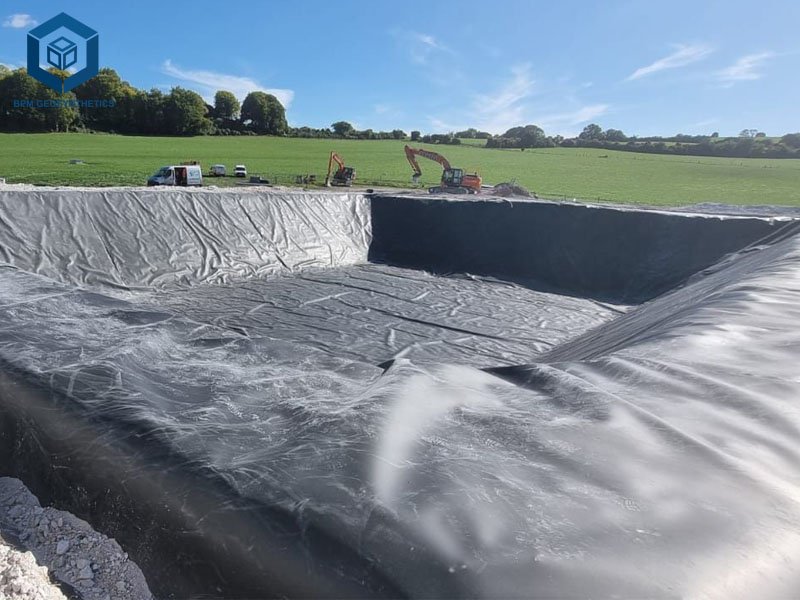
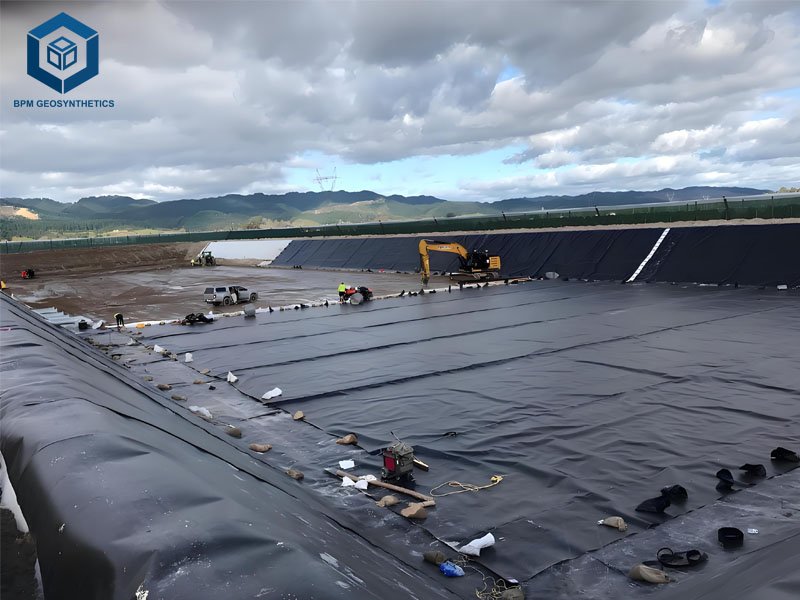
4. Industry Trends Affecting Geomembrane Liner Price
- Raw Material Fluctuations: Oil prices up 10–20%, raising HDPE by 5–8%.
- Wider Rolls: 11.6 m (Atarfil) cuts installation 15%.
- Smart Liners: Sensors (BPM) +5–10%, -20% maintenance.
- Sustainability: Recyclable types $0.50–$3.00/sq ft, +10% production.
- Global Expansion: Asia $0.28–$2.00/sq ft vs. higher in West.
5. Conclusion
Geomembrane liner price in 2025 ranges from $0.50–$3.00/sq ft, with HDPE at $0.50–$2.55/sq ft for large projects and LLDPE at $0.60–$2.50/sq ft for ponds. Installation/logistics add 15–50%; prioritize virgin resin (BPM/GEOSINCERE) for performance. Contact BPM Geosynthetics (BPM Geomembrane) for quotes and samples to ensure leak-proof projects.



